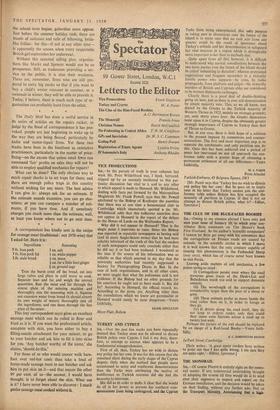Consuming Interest
The End of the Receipt
By LESLIE ADRIAN TODAY, when one buys goods over the counter in Marks and Spencer, no receipt is given— unless you ask for one. Yet I have found this quite satisfactory; if necessary, goods are ex- changed without hesitation later.
Astonishing though it may seem in these days of scientific management, it is a common-sense efficiency measure such as this which makes pos- sible the firm's recent announcement that they are cutting prices. Reductions in the cost of raw materials have been of only secondary considera- tion. A great deal of unnecessary paper work has been cut out; by reducing the entries on one stock sheet alone the firm say they-haVe eliminated the filling-in of eighteen million forms a year.
One cannot but contrast these methods with the ritual of paper and procession which accom- panies the simplest purchase in firms such as Harrods and the Barkers group. Even for a pound of potatoes you are given a duplicate bill of, about half-quartci size. You then have to wander around until you find a cash desk, where a mysterious denizen behind glass takes your money, punches, tears and hands you back change and the carbon-copy half of the bill. Then, with a quite inordinate feeling of virtue and paper proof that you are an OK purchaser clutched in your hand, you make. your way back to the stand to collect the potatoes. It is inconvenient and it must be costly. If one firm can cut it out and pass on some of the benefit to the public, I hope hustling Hugh Fraser and the others will follow Marks and Spencer's lead.
This organisation, which fully justifies its nickname 'Marks and Sparks,' is unique. Its great postwar development has been almost entirely due to an insistence on quality standards. This has not always meant rock-bottom prices—even the new price cuts in shirts and stockings do not undercut some of their competitors—but it has proved' that there is a vast and growing middle- income group in Britain prepared to pay reason- able prices for sound quality.
A walk round a provincial Marks and Spencer store today can give you a fairly clear indica- tion of the spending power and prosperity of a district. For these stores are planned for seasonal selling. Departments move or disappear over- night. When money is short and essentials come first, the food counters come to the fore. Before the school, term begins, gaberdine macs appear. Just before the summer holiday rush, there are stands of suitcases and rails of billowing, bride- like frillies : for this—if not at any other time— is apparently the season when every respectable British girl replenishes her underwear.
Without this seasonal selling plan, organisa- tions like Marks and Spencer would not be so prosperous. Still, as tradesmen providing a ser- vice to the public, it is also their weakness. There are, remember, firms who are still pre- pared to carry big stocks so that if you want to buy a child's winter raincoat in summer, or a swimsuit in winter, they will be able to provide it. Today, I believe, there is much each type of or- ganisation can profitably learn from the other.
The Daily Mail has done a useful service in its series of articles on the repairs racket; to judge by the flood of correspondence it has pro- voked, people are just beginning to wake up to the way they are being fleeced, particularly by radio and motor-repair firms. Yet these two trades have been in the forefront as restrictive practitioners, particularly in the matter of price- fixing—on the excuse that unless retail firms can command `fair' profits on sales they will not be able to employ qualified mechanics for repairs!
What can be done? The only obvious way to catch repair sharks is to set traps for them; and there are enough police traps in this country without wishing for any more. The best advice
I can give is : always ask for an estimate. If the estimate sounds excessive, you can go else- where; or you can compare a number of esti- mates, if you have time. And if somebody charges you much more than the estimate, well, at least you know where not to go next time.
* * * A correspondent has kindly sent in the recipe for sausage meat (traditional : not 1958-wise) that
I asked for. Here it is :
Ingredients Seasoning
9 lb. lean pork 3 oz. salt
3 lb. firm pork fat 1 oz. white pepper
3 lb. stale bread oz. mace / oz. (or a little less) ginger oz. ground sage Trim the burnt crust off the bread, cut into large cubes and place in cold water to soak. Separate lean and fat and weigh the correct quantities. Run the meat and fat through the coarse plate of the mincing machine and thoroughly mix the seasoning with it. Squeeze out excessive water from bread (it should absorb its own weight of water); thoroughly mix all the ingredients; and run them through the fine - plate of the mixer.
This (my correspondent says) gives an excellent sausage meat which can be rolled in flour and fried as it is. If you want the professional article, complete with skin, you have either to buy a filling-nozzle attachment for your mincer, or go to your butcher and ask him to fill it into skins for you. 'Any butcher worthy of the name,' she claims, 'should do this.'
For those of us who would sooner walk bare-
foot over red-hot coals than take a load of home-made sausage meat to our butcher and ask him to put skin on it—and that means the other 99 per cent. of us—the answer, I would have thought, is to forget about the skin. What use is it? I have never been able to discover : I much prefer sausage meat cooked without it.







































 Previous page
Previous page